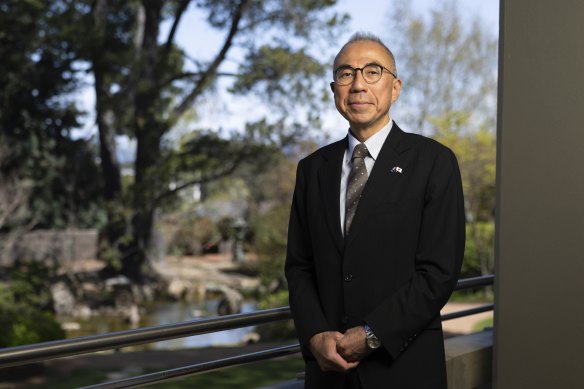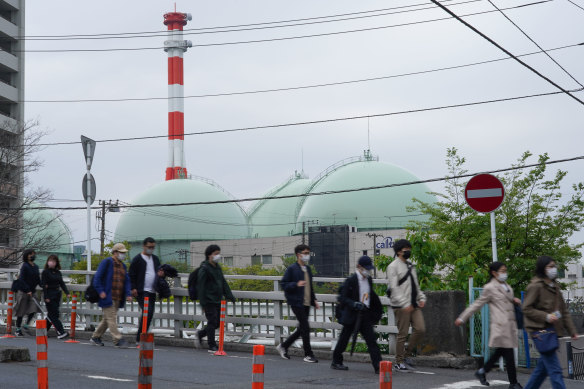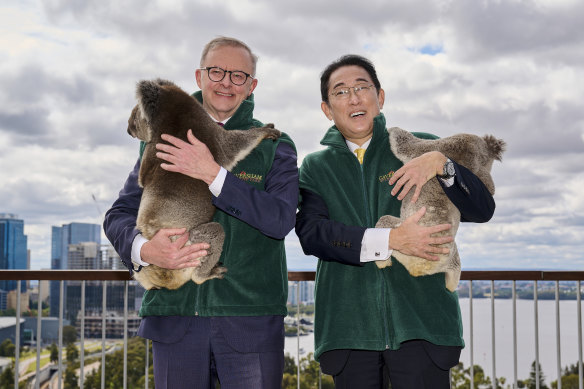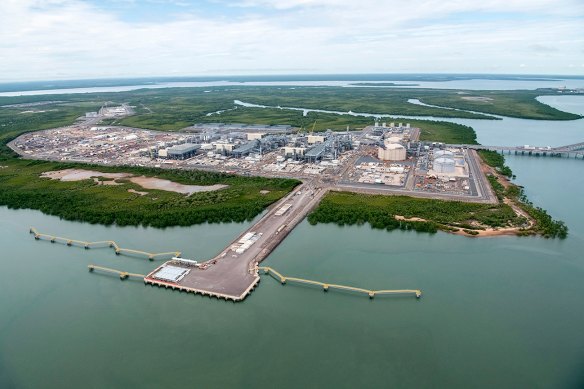Either way, carbon capture, use and storage are hugely controversial. Critics note that it has never succeeded at scale and argue that it is used as a method of greenwashing rather than taking climate action. Even if it was widely deployed, they claim, the whole process is risky. They say that once pumped back underground, there is no guarantee that carbon dioxide will be trapped permanently and safely there. They argue that any leaks could not only contribute to further global warming in the midst of what is already a climate crisis but also damage marine ecosystems.
Loading
They say that rather than building new gas import and export facilities the region should be focused on renewable energy.
And they argue that using captured carbon to force even more gas out of the ground defeats the purpose of capturing it in the first place.
While UN climate experts believe the world will one day need to use carbon capture to reach net zero, they see it as a technology of last resort to be deployed to decarbonise crucial industries like cement or steel manufacturing, not as a crutch for fossil fuels.
The politics
None of this is happening in a vacuum. Earlier this month, there was significant comment when Opposition Leader Peter Dutton gave a particularly combative speech to the Minerals Council of Australia in which he vowed to free the mining industry from “green tape” and environmental activism.
“A government that I lead will not allow activists to dictate economic policy and to pull the handbrake on our prosperity,” he said. “And we will cut green tape while striking the right balance between our responsibilities to the environment and the economy.”

Japan’s ambassador to Australia, Kazuhiro Suzuki.Credit: Alex Ellinghausen
The Australian media paid less attention to the keynote address given by the Japanese ambassador, Kazuhiro Suzuki, at the same event.
In his speech, Suzuki identified Australian and Japanese co-operation on climate change as an opportunity for the two nations, but the co-operation he proposed seemed calibrated to suit the fossil fuel industry.
Loading
He noted that Australia and Japan together generated just 4 per cent of global greenhouse gas emissions, saying that how the world coped with the other 96 per cent would have “far larger ramifications”.
He emphasised that the pursuit of net zero emissions “literally means net zero rather than absolute zero”, and to that end, he said that CCUS and Australia’s depleted gas fields – those empty undersea reservoirs – would be crucial in the regional effort to reduce emissions.
Suzuki went further, too, declaring that Australia could accelerate the CCUS industry with “tax reductions and various forms of public funding” and congratulating Australia’s resources minister, Madeline King, for the government’s future gas strategy.
The speech, says Dr Wesley Morgan, an international relations expert and Climate Council fellow, used the language of climate action while outlining a plan to prolong the fossil fuel era.
And it did not come out of the blue. Japan has been pushing the Australian government on fossil fuels doggedly.

Pedestrians walk by Tokyo Gas Co. storage tanks in Yokohama. Japan has become more reliant on fossil fuels following the Fukushima disaster.Credit: Bloomberg
Ever since the 2011 Fukushima nuclear disaster, Japan has become more reliant on fossil fuels and the large utilities that dominate the sector.
In 2010, fossil fuels generated around 60 per cent of Japan’s power, but by 2012 that was 88 per cent. Since then, it has fallen to 66 per cent, of which liquified natural gas exported from places like Australia makes up at least 29 per cent.
Japan remains determined to ensure its energy security in the face of an increasingly assertive China, and without Australia’s vast open spaces, it has less scope to deploy renewables. It’s been open in its diplomatic efforts to ensure ongoing access to energy from friends like Australia.
When the Queensland government hiked coal royalties in 2022, ambassador Suzuki’s predecessor made a pointed speech to mining students at the University of Queensland, warning the move could damage the “trust and goodwill that Japanese business has built up with Queensland over the years”.
“I fear that this may have widespread effects on Japanese investment beyond the coal industry.”
As the Australian east coast faced gas shortages and politicians faced calls for exports to be curtailed, Japan again voiced its displeasure.
Japanese Prime Minister Fumio Kishida sought a meeting with Anthony Albanese to seek personal assurances over the Australian energy supply, with then-ambassador Shingo Yamagami noting the enormous level of Japanese investment in Australia.
Describing the relationship as “a two-way street” during an interview with The Australian Financial Review, Yamagami said the meeting was “crucial in terms of ensuring that Australia will remain a trusted, reliable supplier of energy”.
“We have to be careful about so-called resources nationalism, and we have to make sure this is a win-win situation, a mutually beneficial relationship.

Minister Anthony Albanese with Japan’s Fumio Kishida in Perth in 2022.Credit: AP
“Japanese businesses have invested a lot in Australia, believing there is no significant sovereign risk. If Australia starts behaving like other countries in some other regions, I’m sure there will be a cry coming from the Japanese,” he said.
Other official signals have been even more blunt. When Australia enacted a law last year requiring new liquefied natural gas facilities to be carbon-neutral on their first day of operations, Japan pushed back hard, saying it would make it impossible for new LNG export terminals to start operations.
“If this issue cannot be resolved, this might undermine long-trusted relations,” Yuki Sadamitsu, director-general of natural resources and fuel at Tokyo’s Ministry of Economy, Trade and Industry, said, according to a Wall Street Journal report.
INPEX, a partly Japanese government-owned oil and gas company, leads a consortium with more than US$40 billion ($58 billion) invested in the Ichthys LNG project off Australia’s north-western coast.

The Ichthys LNG processing facility at Bladin Point in Darwin.Credit: Shaana McNaught
Its chief executive, Takayuki Ueda, visited Australia’s Parliament House in March last year and told an audience there that Australia’s “quiet quitting” of the LNG market threatened regional stability, the WSJ reported.
The incident highlighted how fraught the issue has become for the Australian government as it seeks to maintain its key strategic partnership with Japan, support the gas industry and re-engage in the global fight against climate change.
‘Our targets are real’
Climate Change and Energy Minister Chris Bowen told the WSJ that Australia remained a reliable energy exporter. “But equally our emissions reduction targets are real, and we will not waver on implementing policies taken to the election and passed by our parliament.”
A Bowen spokeswoman told this masthead that Australia was committed to being a trusted and reliable energy exporter into the future “even as we become a renewable energy superpower”.
A report published earlier this month by the independent advocacy group Jubilee Australia shows that Japan has secured a gas surplus. Much of the gas it extracts from Australia does not land in the domestic market but is sold around the region.
‘The idea that somehow … South-East Asian countries are going to capture their carbon pollution … ship it back to Australia and inject it back under the sea and that’s going to be economical? It’s a fantasy’.
Barry Trail, Climate Solutions for Australia director
It cites a survey of 30 Japanese companies, showing that around 32 million tonnes of LNG was sold to third countries by Japanese buyers in the 2022 financial year, as has been the case since 2019.
Meanwhile, climate campaigners are losing patience. Mia Watanabe, a Tokyo-based campaigner at Oil Change International, argues that the Japanese public and private sectors are now involved in long-term gas arbitrage to generate huge profits. “Japan’s on-selling of gas to third countries hampers their development by locking them into decades of outdated, polluting fossil fuels,” she said.
The industry, along with the Australian government, insists gas has a key role in decarbonisation.
Australian Energy Producers chief executive Samantha McCulloch said that by displacing dirtier energy sources, Australian LNG had the potential to cut global emissions by around 166 million tonnes of carbon dioxide each year.
The Western Australian government “has been pragmatic in explaining how Australian gas exports can support decarbonisation in Asia, looking at the bigger world emissions’ reduction goal rather than the ideological political games promoted by activists that would damage Australia’s economy and see a return to coal,” she said.
Last year, 11 nations, including Australia and Japan, launched the Asia Zero Emission Community (AZEC) to pursue emission reductions. However, according to an analysis by Solutions for Climate Australia, of 68 memorandums of understanding signed by the body, 29 support fossil fuel developments.
Ambassador Suzuki rejects criticism of the zero-emissions community. “Since all countries are different in terms of their economy and face different limitations and hurdles for transition, there is no one-size-fits-all model,” he told this masthead.
“AZEC endeavours to achieve ‘one goal, various pathways’.” In other words, all conceivable measures and technologies to reduce emissions are applied as appropriate depending on different national circumstances.
Loading
“Rather than being onlookers and let global emissions increase, Japan and Australia are working together and making realistic contributions to reducing regional and global emissions through AZEC.”
He said projects that did not “leap to zero emissions immediately” could still result in significant reductions – and gas, and that CCUS had a key future role.
But Climate Solutions for Australia director Barry Trail insists the industry is pursuing profit rather than decarbonisation and that CCUS at scale remains financially unrealistic.
“It is not only about making carbon capture technically feasible, it’s about making it economically feasible as well.
“The idea that somehow gas is going to be sucked out in Australia, transported to South-East Asia, burnt, and then South-East Asian countries are going to somehow capture their carbon pollution, liquify it, pump it back into other ships, ship back to Australia, and inject it back under the sea, and that’s all going to be economical?



